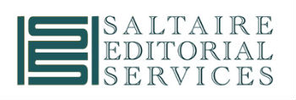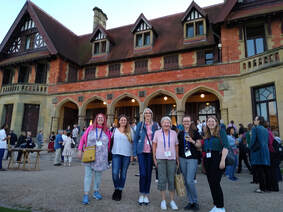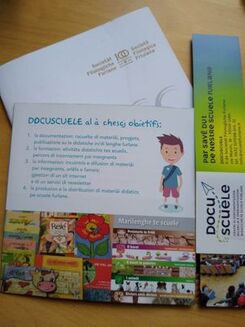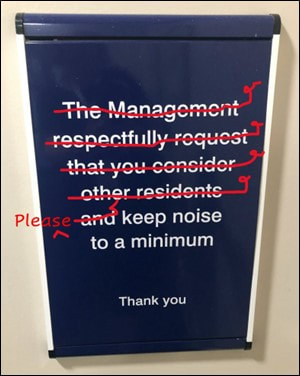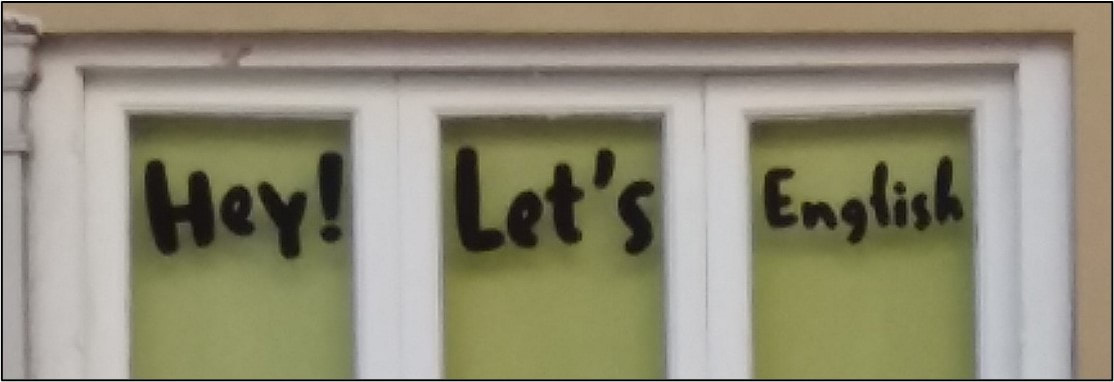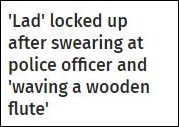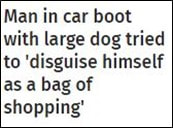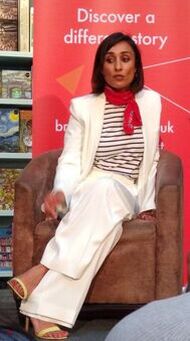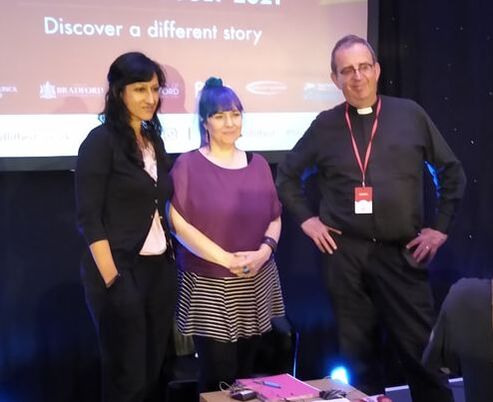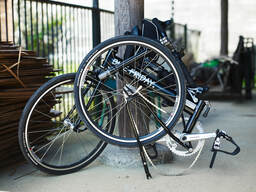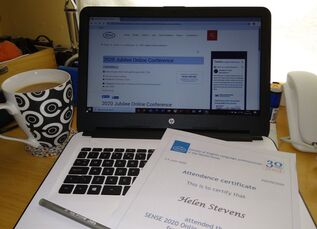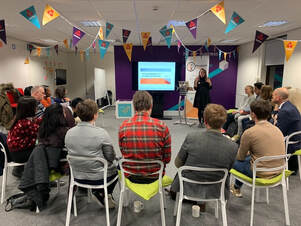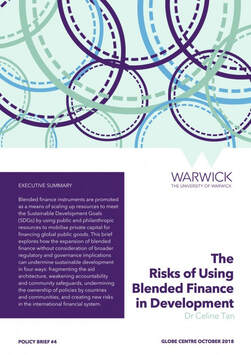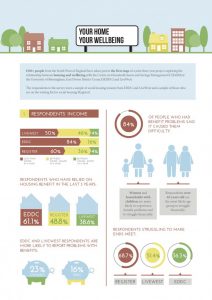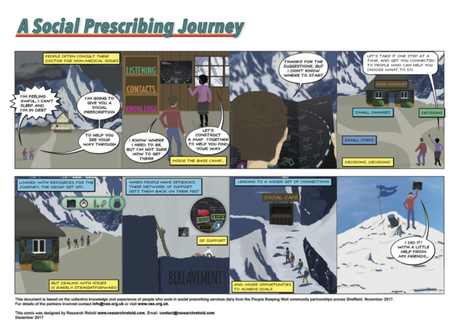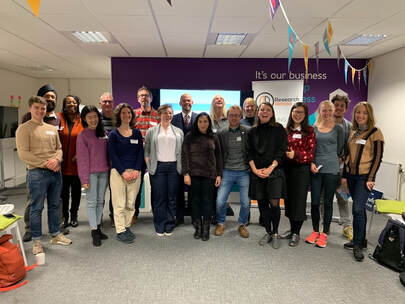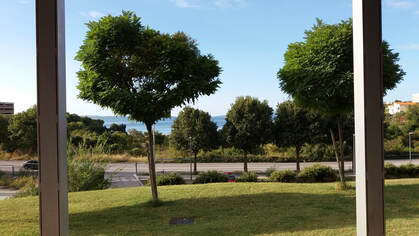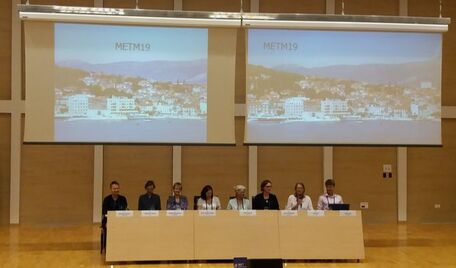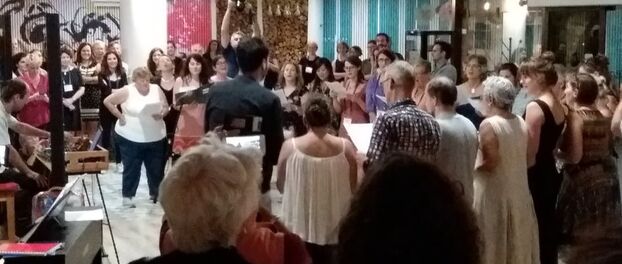|
What’s the most useful thing you learned at school? For me, touch typing would be fairly high on the list. As a youngster, I’d always had a fascination for typing. We had a portable typewriter at home and I loved to play around with it. So when I had the opportunity to learn to type properly, I jumped at the chance. While studying for A levels (aged 17/18), our school timetable had a number of free periods each week that were intended to be used for studying. We were allowed to sign up for ‘extra’ subjects in these periods – and I chose typing. Heavy metal We learned to type on heavy metal typewriters. Starting with our hands on the middle row of letters, our index fingers on the ‘F’ and ‘J’ keys, we practised copying groups of letters from a book until we could type any combination from that middle row. Extending our index fingers to the ‘G’ (left hand) and ‘H’ (right hand) was the next step. For the other rows, we did similar exercises, moving our fingers up to the top row and then down to the bottom, but always returning to that middle row. In all of this, it was important not to look at the keyboard, but instead to focus on the paper where our letters and words appeared. Mistakes – and there were many – were corrected using an ink rubber, which could make a real mess of the paper, especially the flimsy stuff that was used for carbon copies. Typing was a much more physical activity than it is nowadays. Pressing down those metal keys required significant finger strength, and the carriage return lever had to be swiped across from left to right to move the paper up and start each new line of typing. The lessons paid off After two years of lessons, I managed to gain some proper typing qualifications: a CSE (Certificate of Secondary Education) Grade 1, plus RSA (Royal Society of Arts) Grades 1 and 2 and a typing speed of 40 words per minute. Apart from a brief spell using an electric typewriter when I helped to type up a thesis, these skills lay dormant for several years. Most of my university work was written long-hand, and in my first admin job the secretaries did all the typing. By the time I left full-time employment, word processing – mainly using WordPerfect 5.1 – was widespread, so at least I was able to put my skills to some use, which I did whenever I had the chance. When I started freelance editing and proofreading, my workplace experience of WordPerfect 5.1 turned out to be invaluable for gaining on-screen work from an international publisher. This was in the late 1990s, when many freelancers were still working primarily on paper.  My work has changed and developed in the intervening years, but those typing skills remain invaluable. Nowadays, computers of various kinds are a standard feature of office life – and, indeed, of many non-office workplaces too. I know most people who use computers for work won’t have learned to touch type, although many develop excellent levels of speed and accuracy through constant practice. I now use my typing skills all the time:
I also use TextExpander, a tool that inserts standard pieces of text – for example, in comments on a Microsoft Word document – when I type in a keyboard shortcut. It’s faster than my typing and saves me repeatedly writing out the same thing. Having said that, my skills still come in handy for typing the keyboard shortcuts, even if I’m not writing out the whole snippet of text. A key skillI’m so glad I learned to type at a time in my life when my brain found it easy to pick up new things, and before I’d developed any bad keyboard habits! It was several years before I truly realised what a useful skill it is, but I wouldn’t be without it now.
For anyone wondering about the title of this article, I should explain that ‘The quick brown fox jumps over the lazy dog’ is a sentence that’s often used for typing practice because it contains all the letters of the English alphabet. If you’d like to practise your typing skills – or set yourself a typing challenge – why not have a go at this typing game? Warning: It’s addictive! Did you learn to touch type at school or college? Perhaps it’s something you’ve taken up more recently? And if you haven’t had any formal training in typing, how quickly and accurately can you type?
2 Comments
After almost three years of staying relatively close to home (as a result of the pandemic, plus a generally cautious attitude), I decided that 2022 was the year to spread my wings and embark on some foreign travel once more. My previous trip abroad had been in September 2019, when I attended the annual gathering of the Mediterranean Editors and Translators (MET) – the so-called MET Meeting (METM, pronounced ‘met-um’) – in Split, Croatia. Ever since I heard the plans for a meeting in San Sebastián, I’d been thinking about attending. It sounded such a wonderful location. I decided to combine METM with my main holiday, as I had done in Split. But in a break with tradition, I chose to travel there entirely by rail, with stopovers in Paris on both the outward and return journeys, rather than by air, as I would normally have done. I’d visited Spain before, but never the Basque country, so I was keen to experience the delights of San Sebastián. On my first full day in the city I took a bus to another centre of Basque culture, Bilbao. The main attraction there was the Guggenheim Museum, a fascinating structure designed by Frank Gehry and containing some interesting exhibitions. It was well worth the visit, and I enjoyed exploring other parts of Bilbao too. FridayThe following day it was time for METM. My first activity was an ‘Off-METM’ lunch hosted by Jenny Zonneveld. These lunches are small groups focused loosely on a theme (ours was ‘Make the most of your network’, a vital topic for freelancers), aimed at helping delegates to get to know a few others before the conference itself. There were also various optional workshops that delegates could pre-book. To give you a flavour of the conference itself, I’ve summarised the various sessions and presentations that I attended. Because MET is an organisation for both editors and translators, the programme featured some sessions that were relevant to one or other of these different professions, and some that were relevant to everyone. Mentoring: human support in a digital worldTranslator Louise Normandière, who mentors other translators, described the different elements of a mentoring arrangement. All such arrangements are unique and can take different forms, some more formal than others. What they all have in common is that they involve a mentor who is more experienced supporting someone with less experience (and crucially, not necessarily an older person mentoring a younger one). Louise described the qualities of a good mentor: approachability, objectivity, diplomacy and honesty, among others. The mentor must also be willing to listen and learn, because the mentee could well have knowledge to pass on. She also described some of the pitfalls of mentoring and suggested ways in which these could be avoided, as well as characteristics of a successful mentoring relationship. All in all, this was a very useful session on the practicalities of mentoring, encouraging those interested in becoming either a mentor or mentee to take the plunge. Please translate this into five African languages!Timothy Barton, a translator based in Namibia, gave a fascinating insight into minority/minoritised languages and the difficulties of finding suitable translators for them. He described the process he had followed to find translators for different languages when bidding for a UNDP project. Forced to look outside established translation circles, Timothy had found suitable individuals who were employed as journalists and university lecturers, for example. For one language – Kwedam – he had managed to recruit people who were working on a translation of the Bible into that language. Another project, which involved providing subtitles for alcohol-awareness videos, highlighted the issues involved in checking the length of each line of speech in all languages to make sure there weren’t any huge discrepancies. Timothy feels that with his training in translation and his project management skills, he is able to give clients a better all-round service than some agencies can. The projects he mentioned certainly tested his resourcefulness! KEYNOTE: A look inside the multilingual mindCognitive scientist Jon Andoni Duñabeitia – whose work focuses on multilingualism and reading – gave a fascinating account of various aspects of the multilingual/bilingual brain. He used the metaphor of ‘The Good, The Bad and The Ugly’ to characterise how such a brain operates:
Far from simply summarising research in this field, Jon gave insights into the impact of these issues in a wider context. The fact that decisions made in a foreign language can be different to those made in the native language has obvious implications for high-level decision making, for example at European Commission level. In marketing, research has shown that individuals are more likely to accept an unpleasant product (such as insect cookies) if it is described in their ‘foreign’ language. And public health messages – such as calls for people to be vaccinated – can have different effects in terms of acceptance depending on whether they are presented in the ‘native’ or ‘foreign’ language, with evidence to suggest that the foreign language can increase trust and reduce vaccine hesitancy. Even to someone like me who has an essentially monolingual brain, this was all really interesting, and I’m sure the overwhelmingly bilingual/multilingual audience could relate many of Jon’s examples to their own experiences. Welcome receptionFriday drew to a close with delegates gathering at Palacio Miramar, an imposing 19th-century house set in its own gardens on a promontory overlooking the city’s La Concha Bay. We gathered outside for drinks and nibbles, entertained by Ugarte Anaiak (the Ugarte Brothers) who demonstrated the ‘Txalaparta’, a Basque percussion instrument that developed from the tradition of crushing apples to make cider. Realising that a fair few of us hail from Yorkshire, we took the opportunity to snap a couple of group photos. They're a lovely memory of the evening. SaturdayTech, fantasy and the human factor in the time of CovidWhen Courtney Greenlaw took on a translation project and Elizabeth Garrison came on board as editor/reviser, they probably had little idea of how their relationship with each other, and with the author, would develop. Courtney had an initial meeting with the author of the fantasy trilogy, but no further face-to-face discussions were possible because of Covid restrictions. With a range of digital tools at their disposal, Courtney, Elizabeth and the author developed an efficient system of communication that worked for them. They used WhatsApp for ongoing discussions and queries, with in-depth Zoom sessions to explore issues further. This included clarification on characters’ appearances, place names, and descriptions of tools and weapons that don’t exist in the ‘real’ world. This project sounded fascinating, involving as it did the translation of poetry and songs as well as narrative text. There was even a voice-over artist for the multi-media elements of the trilogy! It was a great reminder that there’s no ‘one size fits all’ when it comes to client communication. A flexible (and often imaginative) approach enabled Courtney and Elizabeth to bring this project to fruition under very difficult circumstances. Fathoming Friulian and the unexpected gains in my work as a translatorTranslator Haley Smith first encountered Friulian – a minority language (not a dialect) spoken in parts of northeast Italy – during the year abroad she undertook as part of her undergraduate degree, and she admitted that it came as quite a shock. She now lives in the area where Friulian is spoken and has made significant efforts to get to grips with it, taking evening classes and trying to absorb it in informal contexts. Haley described some of the features of Friulian that are closer to English than they are to Italian, for example in the addition of ‘s’ for plurals. She talked about road signs in the area, which often give place names in Italian and Friulian, as well as the local variant spelling.
While Haley doesn’t translate from Friulian, she has found that a working knowledge of the language has helped in her translation business. She’s aware of certain linguistic features and vocabulary that might be problematic when texts are going to be translated to/from Friulian. Her background knowledge helps her to build relationships with clients. Translation specialisms such as tourism and wine often have a local Friulian dimension, and an awareness of the language can be a USP. And last but not least, the Friulian concept of ‘cumbinin’ (meaning ‘we’ll sort it out together’) is surely a valuable basis for any freelance business. Spit and polish: interactive editingLinda Jayne Turner led this session, in which participants split into small groups and chose one of a number of texts to edit together. This was probably the session that was most directly relevant to my own work and I enjoyed tackling the academic text my group selected. For a start, it was interesting to note that we differed in what we saw as points in the text that must be corrected. And when we did reach a consensus that a particular word, phrase or sentence required attention, our approaches sometimes varied. This was also the case when the different groups fed back to the room, prompting some really interesting discussions. We could have spent much longer discussing these texts, both in our smaller groups and in the room as a whole. It was good to get stuck in and edit some real-life material, and it was particularly useful for those of us who usually work alone to have a chance to collaborate with others in this way. 2022 MET General Assembly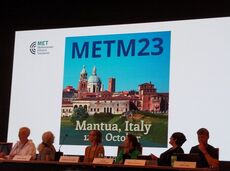 As well as a review of MET’s activities over the year, the General Assembly included an announcement of the venue for METM23: Mantua in northern Italy. Delegates voted on a number of resolutions, and there was an open discussion in which members could raise questions. At the end of the meeting, the raffle was drawn, with a range of editing- and translation-related products and subscriptions up for grabs. Congratulations to the lucky winners! Choppy waters: an editor/translator’s foray into peer review as a submitting authorIt can be a useful experience – though not necessarily a comfortable one – to go through a familiar process from the ‘other’ side. In this presentation, Oliver Shaw described his attempts to have an article published in an academic journal, having previously edited other authors’ papers. Having completed his thesis and presented at academic conferences, he was pleased to be asked to submit a paper to a journal. However, this led to the first of Oliver’s (mistaken) assumptions about the process: he assumed that being asked to submit a paper meant that the journal was keen to publish it, which turned out not to be the case. Another assumption was that he was completely on his own when drafting, submitting and revising his article, whereas he subsequently realised that the journal editor could have provided some support. Perhaps Oliver’s most disappointing assumption was that if he ‘did as he was told’ and followed all instructions and suggestions to the letter, his article would be published. His paper was rejected following resubmission, including on the basis of some points that weren’t raised by the reviewers on initial submission. Oliver became disillusioned with the submission process, although he felt that it gave him a valuable insight into what his author clients had to go through to have their work published. And the good news is that Oliver had a different paper published in June 2022! Sino-Fennish English: minorities working in a third languageAs a native Chinese speaker who lives and works in Finland, Kenneth Quek is well placed to offer an insight into the interplay between Chinese, Finnish and English. To set the scene, Kenneth mentioned a few relevant factors. First, there are increasing numbers of native Chinese speakers in academia and businesses around the world. Second, many Chinese universities require postgrads in STEM fields to publish at least one paper in English in an international journal. And third, a significant number of Chinese researchers collaborate with or work in Finnish institutions, particularly in medicine, forestry and the humanities. In the Finnish context, a number of issues arise when it comes to communicating in English. Most Finnish and Chinese researchers are non-native users of English, so errors are common. Other researchers reading their work are therefore exposed to text containing errors. As a result, these errors become normalised. Interestingly, both Finnish and Chinese are ‘topic-prominent’ languages, with sentences providing a lot of context rather than focusing on the subject (as in English). As a result, pronouns and subjects are often omitted completely: both Finnish and Chinese are ‘pronoun-drop’ languages. As someone who is familiar only with English, I enjoyed this insight into two very different languages, their similarities, the interplay between them and their relationship with English in the context of research. It reinforced the respect and admiration I already feel for authors who are working in one or more different languages (including English). Building an online community – thinking inside the boxKit Cree’s presentation on the different elements of MET’s online community was both interesting and inspiring. Like many other organisations, MET was forced to adapt its activities when the pandemic hit in 2020. This included holding two online conferences, a ‘retrospective’ in 2020 and a virtual event in 2021. MET now has a number of online activities designed to build a supportive members’ community. These include MET Conversations, which focus on specific topics, and a monthly Book Club. During the winter months, members meet online every week for an hour of silent reading, and there’s a private Facebook group where members can discuss books and put forward recommendations. 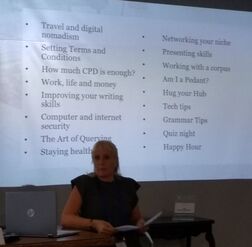 Kit described the ‘7Ps’ of online communities: participants, purpose, platform, profile, procedures, key players and promotion. In explaining each of these, she gave relevant examples from MET’s activities. This session was a really interesting overview of what makes a successful online community. Like many organisations, MET has found new ways to provide support and professional development for its members. Its online activities are a fantastic member benefit. KEYNOTE: In conversation with Sally Orson-Jones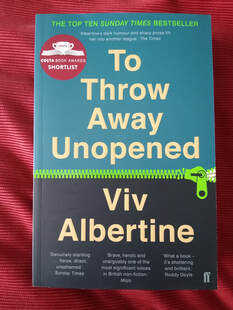 Book doctor extraordinaire Sally Orson-Jones works with a number of well-known authors – Sarah Waters and Viv Albertine, to name but two – to help them to get their manuscripts into shape. In this fascinating conversation with Helen Oclee-Brown, Sally described how she ‘accidentally’ fell into this career, and what her process involves. Sally previously worked in the music industry and for the BBC. A friend of hers, Sarah Waters, asked her to look at the manuscript of her first novel, Tipping the Velvet – and the rest is history! Through this and subsequent projects, Sally was delighted to discover that she had a skill for working with authors to improve their writing. Realising that natural talent was not quite enough, she then embarked on a programme of self-development, educating herself on various approaches and on the terminology used in the industry. Working with an author starts with a Zoom conversation to find out whether the author is a good fit for Sally, and vice versa. If both want to go ahead, Sally puts the author in a ‘queue’, as she is usually booked for months in advance. When the time comes, Sally reads the whole manuscript and adds her comments, before writing a report summarising her advice and suggestions. Another Zoom conversation takes place, during which Sally and the author go through the report. A key part of Sally’s work is managing expectations. Her role for authors is to ‘hold their hand’ and get the book as good as it can be, but that’s no guarantee that it will be published. It’s important that authors understand this, but also know that they can trust Sally to help and support them. This includes working out the approach that is going to be best for each author. For example, one requested that Sally set aside a whole week to go through the manuscript online by sharing her screen. Three of Sally’s books have been published so far in 2022, with more in the pipeline. But the book Sally is most proud of was published in 2018: it’s To Throw Away Unopened, by Viv Albertine, former guitarist for the punk band The Slits (a group that Sally had worked with many years ago). Having read and enjoyed books by Sarah and Viv, I found this conversation particularly interesting. It was good to gain an appreciation of the meticulous work that goes into creating a novel or memoir and to hear how Sally acts as a fresh pair of eyes to shape an author’s material. Goodbye for another year...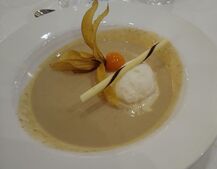 The closing dinner was, as usual, a chance for delegates to dress up a bit, enjoy a meal together and let their hair down at the after-dinner disco. And the following morning, many of them came together for another Off-METM activity – a trip up the funicular railway and a short walk along part of the Camino de Santiago. I chose to have a lie in… I enjoyed my third METM, particularly as I was able to combine it with a holiday again. As I’ve mentioned, some of the sessions weren’t directly relevant to my work, but I found them interesting all the same. Events like METM always give me plenty to think about, and this time I also gained a new perspective by taking the train rather than flying. Oh, and I loved San Sebastián... Here's to METM23!  Some editors and proofreaders complain that their everyday lives outside work are ruined by their professional eye for detail. They can no longer peruse a restaurant menu without noticing a spelling error. Relaxing with a novel is fraught with problems. And as for browsing social media… I’ve been editing and proofreading professionally for over 26 years. As time has gone on, I’ve become more and more tolerant of errors spotted ‘in the wild’. Yes, of course I notice mistakes, and of course these can be a bit of a distraction. But I’ve realised I’m a ‘coin-operated editor’: unless I’m being paid to check something, I’m unlikely to invest time and energy in trying to correct it. I don’t even get annoyed about mistakes any more (unless they make whatever I’m reading misleading or difficult to understand). ToleranceWhen it comes to professionally published texts:
Clarity and plain languageBut there are times when a piece of writing is rather confusing – and I certainly notice when that happens. This sign at a local petrol station had me scratching my head a little and made me wish I could have helped with the wording. And it appears I’m not the only language lover who has an imaginary red pen. Linguist Lynne Murphy photographed this sign at a conference venue recently and couldn’t resist annotating the image (though not the sign itself). Lynne’s version is much clearer than the original! Misplaced modifiers can be another source of confusion (and sometimes amusement), and they’re something I do notice when I’m off duty. I think my favourite example is from a biography of Roald Dahl. With some of her new money she also bought a very early black and white television set. Mounted in a grand wood veneer cabinet, her grandchildren clamoured to come over and watch it. (It surely wasn’t the grandchildren who were mounted in a grand wood veneer cabinet, was it?) So, of course I spot errors. They’re sometimes funny and sometimes confusing – but I wouldn’t normally dwell on them (other than sometimes to think ‘I wonder how that happened…’). What else do I notice?On a more positive note, my editorial eye often catches examples of creative language use, and these often give me great pleasure. VerbificationThis is the formation of a verb from a noun, adjective or other word. It’s been happening for many years (centuries, even), but it’s always interesting to come across new (or new-to-me) instances. This slogan on the window of an English language school in Malaga, Spain, is a great example. Questions of styleStyle points often jump out at me, too. Sometimes that’s when text has been styled in a particularly elegant (or inelegant) way, or when the author has used a technique I don’t often come across. For example, in some US styles guides (e.g. the Chicago Manual of Style) an en dash (–) is used to join an open compound and an adjective. In UK style we don’t have such a neat solution! So when I recently came across ‘Third World–style’ and ‘anti–Viet Cong’ in Andrew Pham’s Catfish and Mandala, I was delighted. I enjoy seeing such examples of things I know about but rarely see, whether I’m reading for pleasure or in my editing work. HeadlinesLast but not least, I’m a huge fan of bizarre or misleading headlines on news websites. Headline writing is a real skill, and coming up with just a few words to sum up a story must be very difficult. But sometimes the technique does raise issues. Tricky hyphenation problem(Perhaps a Chicago Manual of Style en dash would have helped here?) Issues with homonyms ('bodies')Unfortunate phrasingNoun stacking – too many nouns?Bizarre headlines (for bizarre stories)If you’re an editor or proofreader, what do you notice when you’re off duty?
Editors know a thing or two about style. I’m not talking about the chunky cardigans, furry slippers and fingerless gloves that some of us put on when the weather turns cool. This is about an editor’s work. Here, style is about making sure the text is appropriate for its intended audience, consistently applying a client’s style preferences, and – where possible – preserving an author’s voice. This year’s Mediterranean Editors and Translators online conference was entitled ‘The Style Issue’, and there was plenty to interest me in the programme. In this blog post, I’ve summarised three of the sessions that I found particularly useful:
Editors’ Café: one text, two editors, endless talking points In this session, two editors – Alan Lounds and Theresa Truax-Gischler – had a friendly discussion on how they would each tackle the same piece of text. The idea was to get ‘under the hood’ of the editing process from two different perspectives. The text was the abstract and introduction of an article written by an author whose first language isn’t English. The paper was to be submitted to an international interdisciplinary journal on Romani studies. Alan and Theresa also had access to the full article to assist them in their editing task. Both are experienced editors who are accustomed to working with academic authors, although the article was outside their respective subject specialisms. Points to note:
I found this discussion fascinating, as I often edit academic papers in English for multi-language authors. Here are the main points that Alan and Theresa covered. First impressions – Both editors agreed that the paper was nowhere near ready for submission, in terms of either content or style. Context – The author mentioned ‘securitisation’ in the abstract but didn’t define this concept or explain its relevance. This lack of context was a serious issue. Background information – Much of the data given in the introduction was from general sources such as newspapers and non-academic websites, and lacked academic focus. Parallelism
First or third person – Alan preferred first-person writing (‘I studied…’), while Theresa retained the third-person perspective. The two editors discussed the trend towards publishers accepting first-person writing, including the fact that this often depends on the academic subject. As an aside, they noted that Spanish authors (for example) sometimes resist writing in the first person in English because this doesn’t come naturally in their first language. Following a thorough discussion of the two editors’ approaches to the text, several questions from the audience were addressed. Q: Should the abstract be edited first or last? A: Probably last. However, when writing an article, Theresa felt it was useful to start with the abstract because it helps the author to formulate the structure of the paper. Q: What is the role of a developmental editor? A: Their role is to look at ‘big picture’ issues, including the structure and argument of the text. Ideally, copyeditors and language editors should have some basic training in developmental editing so that they can see whether a text is ready to be edited. It was so interesting to see how Alan and Theresa tackled the same piece of text. While there were similarities in their approaches, there were also differences in emphasis. It was proof, if proof were needed, that there’s often no single ‘right’ way to edit a piece of writing. An overview of institutional styles: from excellent tips to the downright weird  Timothy Barton’s presentation was a treat for anyone who – like me – often has to switch between different organisational style guides. Timothy took us on a whistle-stop tour of various guides, including those of the United Nations, the European Commission and the World Intellectual Property Organization. The list of topics covered will be familiar to most editors:
Timothy then mentioned a few style points that seemed open to debate:
Some other great tips emerged:
I found this a fascinating presentation that highlighted the sometimes surprising differences between well-established style guides. Research writing in English: a stylistic conundrum  In this presentation, John Bates considered advice on academic writing, drawing out similarities and potential discrepancies between the different sources. John looked at the definitions of research writing and came up with three key characteristics. The text should be:
John considered various aspects of research writing that could in many cases be improved, in line with these three principles. Use words with care
Nouns and noun phrases Noun phrases can often be a source of confusion for readers. Take the example ‘infant observation’: does that mean ‘observation of infants’ or ‘observation by infants’? Longer noun strings can raise even more issues, especially if they’re used to mean different things in the same piece of writing. Subjects and verbs In most cases, these should be as close to the start of the sentence as possible. Long introductory phrases mean that readers have to keep a lot in their heads before they reach the subject. Rounding off his presentation, John – referring to comments by Thomas Spratt in 1667 – pointed out that criticism of academic writing goes back a long way. From George Orwell and Michael Crichton to contemporary authors such as Michael Billig (Learn to Write Badly) and Helen Sword (Stylish Academic Writing), plenty of people have had plenty to say on how researchers should communicate their findings. Have things have improved over the years? John feels they haven’t! An audience member asked about respecting the author’s voice when editing academic writing, especially when that voice is rather ‘flowery’. John acknowledged that this could be a problem. The editor often has more leeway if the text is written by an author whose first language isn’t English, because there’s an expectation that the editor will amend the language to make it clearer and more concise. And if the author’s first language tends towards more elaborate constructions, that could well be mirrored in the English version. There was so much more to METM21 than I’ve summarised here, and I’ve yet to catch up with the recordings of the sessions I wasn’t able to attend in real time. The hope is that next year’s conference will take place in person, in San Sebastián, Spain. And if that’s the case, I’m hoping I won’t need to pack my fingerless gloves. I’ve been a big fan of Bradford Literature Festival for a number of years. It’s a bright spot in Bradford’s cultural calendar and I’ve written in the past about why I love it. In previous years I’ve usually attended a fair few sessions during the annual festival. I’ve loved the variety of subjects on offer, the chance to hear interesting (and well-known) speakers in some marvellous venues, and the opportunity to listen, learn and reflect – and often to be challenged. This year – as a result of the general uncertainty and a lack of organisation on my part – I attended only two events. But what this year’s festival lacked (from my point of view) in quantity, it certainly made up for in quality. Anita Rani
As a trailblazer – a South Asian woman in a predominately white male industry – Anita talked about the difficulty of negotiating various ‘spaces’ and having to curb aspects of her personality to meet certain expectations. She has clearly thought long and hard about the privileged position in which she now finds herself, about how she could – or should – use that position to carve a path for others, and about her regrets for not speaking out on particular occasions. Many of Anita’s reflections also touched on the personal sphere. She talked about food, family and weddings. She talked about how South Asian girls were mostly not encouraged to speak up, except on the topic of beauty. And she wondered how much the lives of women (particularly those from South Asian backgrounds) have changed since she was growing up. This was an entertaining and thought-provoking discussion. Anita’s book is now on my reading list. Rev. Richard Coles and Arifa Akba The setting for Sunday evening’s event was the magnificent ballroom at Bradford’s Midland Hotel. The topic – grief – was a more sombre one than Saturday’s, although there was plenty of light on hand, not least from the amazing chandelier that graces the venue. Rev. Richard Coles and Arifa Akba were interviewed by Peg Alexander. These were two quite different stories, with some common threads. Richard Coles’ husband, David, died in December 2019 as a result of addiction to alcohol. Arifa Akbar’s sister, Fauzia, died in 2016 from undiagnosed tuberculosis. Both deaths were a shock, yet in some ways not really a shock, perhaps complicating the grief that these two authors have felt since. There were other common observations – and ones that anyone who has ever been bereaved will recognise. For instance, when someone dies there is a huge amount of ‘admin’ to deal with, sometimes lasting many weeks (or even months). This can, in one sense, be welcomed as something practical to focus on, but it can also be exhausting. Another aspect of grief is the baffling realisation that everyone else is carrying on as normal with their everyday lives, while you’re still dealing with the enormity of your bereavement. Richard and Arifa each reflected on what had helped them to deal with the grief they felt. As a widow, Richard didn’t appreciate being told by others how he should be feeling and behaving, but did value conversations with other widows who told him how they themselves had felt/behaved, without giving advice. Meanwhile, Arifa noted that the loss of a sibling isn’t as widely recognised as the loss of a spouse is, something that left her feeling rather adrift. Coincidentally, two of her close friends had also lost siblings, so Arifa was able to discuss her feelings with them. The two authors also discussed addiction and attitudes to it. David’s alcoholism wasn’t public knowledge, so many were shocked by his death. Richard described the strain of living with and caring for an addict: he often went without sleep so that he could make sure David was safe. Arifa described the complex issues associated with her sister’s eating disorder – a type of addiction – including the shocking negative comments made by a member of medical staff. Arifa and Richard touched on the way in which grief had affected their relationship with art and music, respectively. Fauzia was an artist who had created striking paintings and embroidered art. She had been deeply affected and inspired by the Sistine Chapel, leading Arifa to visit the Vatican after her sister’s death to share that experience and feel a connection with Fauzia. Richard and David had played music together, so Richard had avoided revisiting their shared music after David’s death because it was just too painful. Instead, he had decided to learn to play a new instrument: the accordion. There were some interesting questions from the audience. Had Arifa considered taking legal action for her sister’s undiagnosed fatal illness? She’d certainly discussed the possibility with a lawyer she knew, but decided not to pursue it in the end because of the time, effort, stress – and money – involved. Did the two authors feel that David and Fauzia had experienced a ‘good death’? Perhaps surprisingly, given the circumstances, both Richard and Arifa said they did. As it happened, this was the final question, and it was a positive note on which to end the discussion. And so ended my Bradford Literature Festival 2021. It was brief, it was bright, it was brilliant. I can’t wait for next year…
When you’re building a career as a freelance editor or proofreader, it’s good to seek advice, right? The trouble is that, as with many situations in life, there’s no single ‘right’ way of doing things. A while ago I read a tongue-in-cheek blog post summarising conflicting advice on how to be a successful academic. It inspired me to think about the nuggets of wisdom that are often presented as undisputed truths to those seeking guidance about running an editorial business. Here’s my summary. 1. Devote plenty of time and effort to social media – but also don’t✅ Twitter, Facebook, LinkedIn and Instagram can be great for raising your profile, engaging with potential clients and building relationships with colleagues. ❌ But social media can be a real drain on your time and energy. How does it fit into your overall marketing strategy? Would your efforts be better directed elsewhere? 2. Rely on word of mouth to gain new clients – but also don’t✅ If people pass your name on to others, that’s great! It involves little effort on your part – other than ensuring you’re always providing an excellent service, of course. ❌ But it can be risky to rely on this as a strategy for finding work. What if the referrals dry up? How will you find new clients (or how will new clients find you)? 👉 Further reading: https://www.louiseharnbyproofreader.com/blog/word-of-mouth-marketing-for-editorial-freelancers-and-why-it-wont-work-if-youre-a-passive-marketer 3. Always charge an hourly rate rather than a rate per 1,000 words – but also don’t✅ With an hourly rate, you should – in theory – be paid for the time you put in. ❌ But a rate per 1,000 words (or per project) rewards the efficient editor who uses time-saving tools and techniques. It also means the client knows in advance how much the work will cost. 👉 Further reading: https://aceseditors.org/news/2021/what-type-of-pricing-structure-should-freelance-editors-use 4. Refuse to edit in anything other than Microsoft Word – but also don’t✅ If you’re skilled in using Word, it makes sense to focus on clients who use it. ❌ But you might be missing out on some interesting projects. Could you extend your skills into new areas [Google Docs, Excel, PowerPoint] to tap into different markets? 5. Refuse to work for free – but also don’t✅ Working for free – often on the promise of exposure or further work, or for a client pleading poverty – is a mug’s game to be avoided at all costs. ❌ But if you’re looking for experience and the chance to practise your skills, perhaps for a worthwhile cause, you might gain as much as you ‘lose’ by volunteering your services. 👉 Further reading: https://www.forbes.com/sites/nextavenue/2018/05/14/when-should-you-work-for-free/?sh=7a229d58f556 👉 Also see this handy flowchart by typographer, graphic designer and lettering artist Jessica Hische: http://www.shouldiworkforfree.com 6. Always stick to your desired rates – but also don’t✅ Accepting low-paid work can leave you caught in a trap of working for less than you’d like. ❌ But a low-paid project can sometimes have other benefits (raising your profile, giving you experience, providing at least some income), so it could pay off. And a big project with a lower rate might prove more profitable than several smaller ones with higher rates, as there’s less admin and set-up time involved. 7. Only work on material within your own subject area – but also don’t✅ It’s great to carve out a specialist niche where you can apply your skills and expertise and feel comfortable with the subject matter. You can also market yourself as an expert. ❌ But restricting yourself to a niche can leave you high and dry if that market collapses. You’re also cutting yourself off from other subject areas and new types of work. And sometimes your perspective as a non-specialist can be valuable to the client, especially if the target audience aren’t experts either. 👉 Further reading: https://northerneditorial.co.uk/2016/03/25/to-specialise-or-not/ 8. Find your own clients rather than working through an intermediary – but also don’t✅ Working directly for your own clients allows you to quote the rates you want, set your own timescales and establish yourself as an independent professional. ❌ But you have to find these clients yourself. Working for an intermediary (such as an agency) takes the pressure off, marketing-wise, and can often provide a steady flow of work. 👉 Further reading: https://www.louiseharnbyproofreader.com/blog/who-finds-your-editing-and-proofreading-clients-for-you 9. Avoid showing your personality in the work environment – but also don’t✅ It’s important to present yourself as a serious professional who can be trusted to do an excellent job. Clients aren’t interested in your personality. ❌ But clients are individuals too. Their purchasing decisions can be influenced by personal factors, so there’s nothing wrong with showing your character if the circumstances are right. And finally… 10. Take advice and inspiration from colleagues – but also don’t✅ The editorial profession is a collegiate one. You should follow every piece of advice to the letter, while closely emulating other editors and proofreaders in running your business. ❌ But this will inevitably lead to frustration and burnout. By all means seek advice and observe how others run their affairs. Keep in mind, though, that not all advice will suit your situation (and a lot of it is contradictory anyway). What works for one person might not work for everyone. 👉 Further reading: Here’s the article that inspired this blog post, 10 steps to Becoming a Successful Academic – the definitive guide.
What conflicting pieces of advice have you been given? [With thanks to Laura Ripper for comments and proofreading.] Freelance editors and proofreaders: have you ever felt as though you’re ‘muddling through’ in your professional life? You’re not alone. The current situation has forced many of us to adjust our plans on a daily (hourly?) basis. But even without a pandemic, freelancers have to adapt to changing circumstances and come up with new plans and different ways of working. I’ve called this ‘muddling through’, but you could also call it flexibility, resourcefulness and ingenuity. Here are seven areas where this flexibility and resourcefulness will come in handy. It’s not intended to be a list of things to worry about! Instead, it’s a recognition of the creativity and pragmatism that many successful freelancers display. 1. Your initial business ideaMost of us start out with some idea of the work we’d like to do, or for which we’d be most suited. With my NHS background, I thought I’d be the ideal person to work on health- or HR-related material. However, my first publisher client specialised in non-fiction books for the general reader, so that was that – at least initially. You might have to review your initial business idea in the light of various factors:
If you’re determined to stick to your original vision, that’s fine. But it’s worth keeping an open mind about the direction you’re going to take. 2. Finding work and clientsAsk a group of freelance editors or proofreaders how they find work and you’ll end up with a list as long as your arm. Some take the direct approach, contacting potential clients with speculative enquiries. Others rely on word of mouth from professional or personal contacts, or repeat business from returning clients. Most find they need to be visible, whether that’s on their own website, through a directory or bidding site, or on social media. Networking can be successful for some. And then there’s the element of luck – the chance encounter with a potential client in an unexpected place (on a train, in the school playground, at a Zoom book club), or simply the ‘you happen to be just what we’re looking for at this moment in time’ scenario. It’s important to plan for finding work and clients so you can focus your efforts to best effect. But it also pays to be alert, flexible and ready to respond to new opportunities. To quote Louis Pasteur: ‘Chance favours the prepared mind.’ 3. Technical issuesOver and above the required editing and proofreading skills, it’s vital that you have a general level of technical proficiency. You never know when you’ll need to adapt. Yes, you might be a whizz with Microsoft Word and all its features and add-ins. But what if a client suddenly wants you to proofread a pdf or a PowerPoint presentation? What if you’re asked to work in Google Docs? It’s not about being an expert in everything. But it’s useful to be able to use a variety of tools when working on different projects. For example, you might copy text from a pdf into Word so you can use PerfectIt or your favourite macros. Copying a table of figures from Word to Excel can be a quick and accurate way of checking an author’s calculations (if that’s part of your brief). Then there’s ‘Maggying’ a corrupted Word document – copying everything except the final paragraph marker into a new document. And would you know where on your computer to look if you couldn’t find the document you’d been working on? It’s impossible to anticipate all possible scenarios and plan for them. But you do need to be able to think laterally if something unexpected happens – and to know when (and where) to seek help from others if you can’t solve the issue yourself. 4. Working hours Are you a morning person? Or do you do your best work while burning the midnight oil? It’s great to be able to choose your working times – and to decide how long you’re going to spend at work – but sometimes you might need to adjust things. How do you cope if you need to put in extra hours? Can your working space accommodate changes (for example, if you share the facilities with other family members)? How do you cope physically with doing a ten-hour day instead of your usual five hours? Again, flexibility is the key. You need to take breaks more frequently if you’re working longer hours. Are there some tasks that don’t require quite the same level of focus as others? If so, could you work on those when your concentration is waning (in the evening, perhaps)? Can you work somewhere else if need be? 5. EquipmentMost of us would admit that we take technology and equipment for granted. We carry on with our work routines assuming that everything will run as it should. But if disaster strikes, emergency action might be required. Saving your work in the cloud is sensible because it means you can access it from another device (if you have something suitable). If your internet connection goes down, you might have to use your mobile data as a short-term solution. Pre-pandemic, you might have chosen to de-camp to your local coffee shop and use their wi-fi, and we’re all hoping that’ll be possible again before too long. Home-based freelancers might even have kind neighbours who can help (a spare laptop cable here, some emergency printing there). While it’s useful to have a back-up plan (an old laptop you could bring back into service if your main computer fails, for example), it’s impossible to prepare for every eventuality. Again, it’s a question of thinking creatively, recognising when and where to ask for help, and knowing at what point to discuss the situation with your client if you’re not going to meet the deadline. 6. Personal or domestic emergenciesA sudden illness, a chronic medical condition, a relative needing help, unexpected childcare demands, not to mention burst water pipes and power cuts … these problems aren’t exclusive to freelancers (nor do they only happen during a pandemic). But if you’re working to a deadline, with no one else who can step in to do your work, situations like these can make things very difficult. Of course, some people choose freelancing precisely because it enables them to work around their personal circumstances, whether that’s their own health condition or their caring responsibilities for children, elderly relatives – or even pets. It’s when the unexpected happens that additional problems can arise. Once again, some extra flexibility is the key. Could you take a break from work and make the time up once the situation is resolved? Perhaps you can temporarily rearrange your working hours? Is there anyone who can help with childcare, even if it’s on a video call with your child while you work for a while? Freelancers often worry about telling their clients about emergencies like this, feeling that it might make them seem unprofessional. I’ve found that clients are usually very understanding about such situations, especially if you can suggest a solution (an alternative deadline, for example). And most clients would rather know you’re struggling, even if you end up not needing extra time to finish the work. After all, they’re human too! 7. Losing a major clientIt’s great when you’ve managed to secure plenty of regular, enjoyable work from a client who pays well and is nice to deal with. It’s not so great if that client suddenly disappears for some reason (bankruptcy, merger or takeover, taking the work in-house, etc.) and you’re left with a gaping hole in your work schedule. This is something that’s happened to me on a couple of occasions, and it can certainly feel like the rug has been pulled out from under your feet. Clearly, you need to respond, but how you respond will depend on your circumstances. Here are a few ideas:
So there we have it – a quick look at how a flexible, responsive approach will help in running your business. Yes, freelancing might sometimes feel like ‘muddling through’, but perhaps we should instead see it as being creative and developing resilience. That sounds much more impressive! Further readingDon't panic! How to stay calm in a crisis - CIEP blog – by Melanie Thomson
Seven things freelancers know about time – by Liz Jones How freelance editing prepared me for working through the pandemic – and how it didn’t – by Liz Jones 2020: Lessons from the Longest Year – by Crystal Shelley Buck the trend: strengthening your business during lockdown – by Rachel Gristwood How to be lucky – by Christian Busch
Many of us have been terribly disappointed over recent months when the inevitable has happened – an in-person event (whether that’s a summer fête, rock concert, conference or networking session) has been cancelled because of the pandemic. The upside is that many events have gone virtual, enabling people to attend events that they wouldn’t otherwise have access to.
And so it was that I signed up for the SENSE 2020 Conference. SENSE is the Society of English-language professionals in the Netherlands, and this year’s event marks the organisation’s 30th anniversary. The plan had been to hold the conference in Maastricht. If that had gone ahead, it’s unlikely that I’d have been able to attend in person. However, when it moved online, taking place over three afternoons in June, I decided to book a place. As it happened, the conference coincided with a confluence of deadlines in my work, something I’d have taken steps to avoid if I had been travelling to Maastricht for a few days away from my desk. As a consequence, I decided to concentrate on those sessions that seemed most relevant to my work as an editor. In this article I describe just six of those sessions, in an attempt to give a flavour of the conference and to illustrate its relevance to all language professionals. There are full details of the programme on the SENSE website. I’ve chosen to write up a summary and my impressions of the following sessions:
Be(a)ware of (round) brackets (especially ‘Dutch’ ones)! |
| We considered the benefits of communicating research to different audiences outside the research community, and the various methods that could be used. Here are some of the key points that came out of the presentation by Research Retold’s founder, Mihaela Gruia, and the discussion that followed. |
Why is communicating research important?
- There’s evidence that a significant proportion of academic papers are never actually read.
- To maximise the impact of research, the findings need to be communicated so that they can be put into practice.
- With so much information and misinformation in circulation, it’s important that people can go back to the source to check the facts.
- Researchers often need to work hard to engage participants. Feeding results back to them helps to reinforce this.
- A great deal of research is publicly funded, so it’s only right that the findings are disseminated widely.
- Researchers can gain clarity on their own work when they have to explain it to others.
Tips
One technique for focusing the mind on the key aspects of a piece of research is to try to sum it up in 60 seconds – an elevator pitch, if you like.
The description should answer the following questions:
The description should answer the following questions:
- What problem did you address?
- How have you investigated it?
- Why should people care?
Different audiences
The starting point in communicating research is the intended audience:
- Who are they?
- Why do you want or need to communicate with them?
- Why should they care about your research?
- For policymakers, the information needs to be clear and concise, but with sufficient detail to convey the key points. Here, policy briefs and visual summaries can be appropriate.
- For business and the private sector, visual summaries and infographics catch people’s attention. It’s important to keep the presentation simple and to the point.
- For the media, a visual format can be appropriate, as can a more traditional media release. The Conversation is a useful outlet for researchers wishing to share their work with a non-research audience.
- For the general public, again, visual formats and media releases can work well. ‘General public’ might also include end users (for example, groups who will be directly affected by the research). Infographics and infocomics are eye-catching as well as informative, and they can be useful for storytelling.
A valuable event
For me, this event was a valuable opportunity to discuss research communications with real-life researchers. In turn, the researchers seemed to appreciate the chance to think about why, how and with whom they should share their findings.
It was good to step back from the words on the page and consider the wider aspects of communicating research. Thank you, Research Retold, for providing a forum for us all to do this!*
It was good to step back from the words on the page and consider the wider aspects of communicating research. Thank you, Research Retold, for providing a forum for us all to do this!*
*Special thanks to Mihaela Gruia for giving permission for all the above images to be used. All are taken from the Research Retold website.
Three years ago I was inspired to write my very first blog post after a trip to Tarragona in Spain. I’d attended the annual gathering of the Mediterranean Editors and Translators (MET) – the so-called MET Meeting (METM, pronounced ‘met-um’) – and this made me think about how international my work had become since I started freelancing.
This year, I decided it was time for a return visit. METM19 was in Split, Croatia, and I decided to combine the event with my annual holiday.
I spent a lovely few days acclimatising myself to Split and enjoying the wonderful weather. It’s a fascinating place with a beautiful seafront and plenty of historical interest (especially Diocletian’s Palace, which was built for the Roman emperor Diocletian in the fourth century AD and is now a maze of narrow streets full of homes, shops and restaurants).
This year, I decided it was time for a return visit. METM19 was in Split, Croatia, and I decided to combine the event with my annual holiday.
I spent a lovely few days acclimatising myself to Split and enjoying the wonderful weather. It’s a fascinating place with a beautiful seafront and plenty of historical interest (especially Diocletian’s Palace, which was built for the Roman emperor Diocletian in the fourth century AD and is now a maze of narrow streets full of homes, shops and restaurants).
When it came to METM itself, my first activity was one of the ‘Off-METM’ lunches. These are small groups focused loosely on a theme (ours was ‘Feedback is a two-way street’), aimed at helping delegates to get to know one another before the conference itself. There were also various optional workshops that delegates could pre-book.
After lunch, we headed to the School of Medicine at the University of Split for the start of the official proceedings. To give you a flavour of the conference itself, I’ve briefly summarised the various sessions and presentations that I attended. Because MET is an organisation for both editors and translators, the programme featured some sessions that were relevant to one or other of these different professions, and some that were relevant to everyone.
After lunch, we headed to the School of Medicine at the University of Split for the start of the official proceedings. To give you a flavour of the conference itself, I’ve briefly summarised the various sessions and presentations that I attended. Because MET is an organisation for both editors and translators, the programme featured some sessions that were relevant to one or other of these different professions, and some that were relevant to everyone.
Can we make the world a better place? Realities, roadblocks and rewards for language professionals who work for philanthropic causes
Chaired by Valerie Matarese, this discussion featured Timothy Barton, Karen Shashok and Sandra Young talking about their work – both paid and unpaid – with various charitable or humanitarian clients. It was an interesting insight into how language professionals can apply their skills in different ways (and in different parts of the world).
KEYNOTE:
Translation and writing in a corporate environment: making it count in the C-suite
David Jemielity from the Swiss bank BCV described how he has worked to raise the profile of the bank’s translation department. The department now has a much greater influence on the company’s overall communication activities, rather than simply being involved in translating the finished version of the text: ‘Our quality test changed from “Is that a good translation?” to “Is that effective communication?”’
David stressed the need to offer solutions, not problems, and to show your clients that you follow their particular field (for example, the terminology that is used). Much of this advice was relevant to editors as well as translators.
David stressed the need to offer solutions, not problems, and to show your clients that you follow their particular field (for example, the terminology that is used). Much of this advice was relevant to editors as well as translators.
Friday’s proceedings came to a close with the welcome reception, at which we were treated to drinks, canapes and a Croatian speciality, soparnik (chard pie). This last item was a great talking point because of its size: it was very thin, but a couple of feet in diameter. Impressive stuff!
Saturday dawned with yet another clear blue sky (this superb weather was getting tedious…) and I headed to the School of Medicine for a full day of METM activities.
Content marketing 101 for translators
Content marketing is a hot topic for editors and proofreaders, and one that has featured on the programme at previous Society for Editors and Proofreaders (SfEP) conferences that I’ve attended. Translator Maeva Cifuentes explained the concept and illustrated the benefits using the results of the content marketing activities she has undertaken for a client. She stressed the need to take a strategic approach and to evaluate results regularly.
Thinking of teaching a course on scientific writing?
Although I’m not thinking of teaching such a course, I found this presentation by Ann Bless really interesting. Ann described how she helps PhD students to improve their academic writing skills using a combination of guidance and peer critiquing. She included lots of salient points that were relevant for editors like me who work with individual academic authors. Ann’s book, Reader-friendly Scientific Articles, is worth checking out.
Building a language professional–academic co-working partnership
Translator Wendy Baldwin described her experience of LPACs (language professional–academic co-working partnerships). I’m familiar with accountability groups from the editing community, and these partnerships do seem to share some of the same aims. The idea of LPACs is that the partners meet regularly (either in person or virtually) to work on their own projects – whether writing, editing or translating. Each meeting starts with a sharing of goals for the session, and at the end of the hour the partners discuss what they’ve achieved, and whether they’ve met these goals. Wendy highlighted two main benefits of LPACs, namely the opportunity for knowledge exchange, and increased focus and motivation.
2019 MET General Assembly
As well as a review of MET’s activities over the year, the General Assembly included an announcement of the venue for MET20: San Sebastián in the Basque Country. If the applause and the exclamations of delight were anything to go by, this was a very popular choice.
The chair invited questions and comments from the floor. One of these prompted a lively discussion on the need to consider the environmental impact of future events, including everything from travelling to METM to using plastic cups and conference swag bags. Plenty of food for thought.
And speaking of food, the General Assembly was followed by a buffet lunch, at which we once again enjoyed soparnik (among other tasty dishes).
The chair invited questions and comments from the floor. One of these prompted a lively discussion on the need to consider the environmental impact of future events, including everything from travelling to METM to using plastic cups and conference swag bags. Plenty of food for thought.
And speaking of food, the General Assembly was followed by a buffet lunch, at which we once again enjoyed soparnik (among other tasty dishes).
The pitfalls of comparison in scientific writing
David Barick used real examples to highlight problems with different types of comparison – both between variables in the results of a single academic study and between the author’s findings and those in the literature (where the tense used will be particularly important in drawing a distinction between current and previous research).
Preparing the winning quote – effective job estimates
 Jenny Zonneveld
Jenny Zonneveld In this comprehensive overview of what should be included in a quotation for a client, Jenny Zonneveld gave a detailed run-down of all the tasks involved at every stage of the process. She outlined the various factors to consider when preparing a quote, including the thorny issue of whether a fee per word, per hour or per project is appropriate.
Insights from 30 years’ collaboration: an analytical memoir from an author and his manuscript editor
Spanish clinician Jaume Canet has published many papers over several decades, and editor and translator Mary Ellen Kearns has provided editorial support for him throughout that time. In this presentation, Mary Ellen described the various stages of Jaume’s career, highlighting his prolific publication record and the types of support and input required over the years.
KEYNOTE:
The evolution of concision: editors’ role in changing English
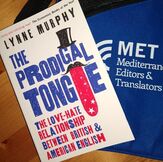 Lynne Murphy's The Prodigal Tongue
Lynne Murphy's The Prodigal Tongue The closing keynote of METM19 was given by linguist Lynne Murphy, author of The Prodigal Tongue. The book’s subtitle is ‘The love–hate relationship between British and American English’, and Lynne described some of the differences in the language on the two sides of the Atlantic. Relating these to the METM19 theme (‘Making it count: communicating with clarity and concision’), and specifically the concision aspect, she explained the process of ‘densification’, in which language becomes more informationally dense over time. I’d heard Lynne speak before (at the SfEP conference and at Leeds Literature Festival), so I was expecting this to be an interesting and entertaining session. I wasn’t disappointed! (I hope Lynne will permit that last piece of punctuation: she allows her students one exclamation mark per year, and advises them to use it wisely…)
And with that, all that remained was for delegates to make their way to the closing dinner and afterparty. The four-course meal was served at a pace that could best be described as ‘leisurely’ (we were still waiting for dessert at 12.30am). I’m not sure whether this was a Croatian tradition, or whether catering for such a large group had proved challenging for the restaurant. Nevertheless, the food was tasty and I enjoyed the conversations over dinner, with Lynne Murphy on one side and Rebecca Warden from International Correspondents in Education (one of my main clients) on the other. The METM choir also entertained us with a couple of numbers.
Although the disco was just getting going as dessert was being served, I’m afraid I was ready to make my way back to my apartment as 1am approached.
I very much enjoyed my second METM and I hope it won’t be my last. The programme was interesting and varied, the people friendly and approachable, and the setting lovely. I met individuals from all over Europe and beyond, attended informative sessions given by presenters from a range of backgrounds, and came away with a renewed sense of the importance of language professionals in an increasingly globalised world.
Oh – and I sampled soparnik!
I very much enjoyed my second METM and I hope it won’t be my last. The programme was interesting and varied, the people friendly and approachable, and the setting lovely. I met individuals from all over Europe and beyond, attended informative sessions given by presenters from a range of backgrounds, and came away with a renewed sense of the importance of language professionals in an increasingly globalised world.
Oh – and I sampled soparnik!
Categories
All
Clients
Editing
Facebook
Freelancing
Literature
Microsoft Word
Mindset
Proofreading
School Reports
SfEP
Skills
Social Media
Travel
Writing
Yorkshire
Archives
December 2022
October 2022
November 2021
July 2021
March 2021
February 2021
June 2020
February 2020
October 2019
July 2019
June 2019
May 2019
February 2019
October 2018
July 2018
June 2018
April 2018
February 2018
January 2018
December 2017
November 2017
October 2017
May 2017
February 2017
January 2017
November 2016
October 2016
Read my Privacy policy
